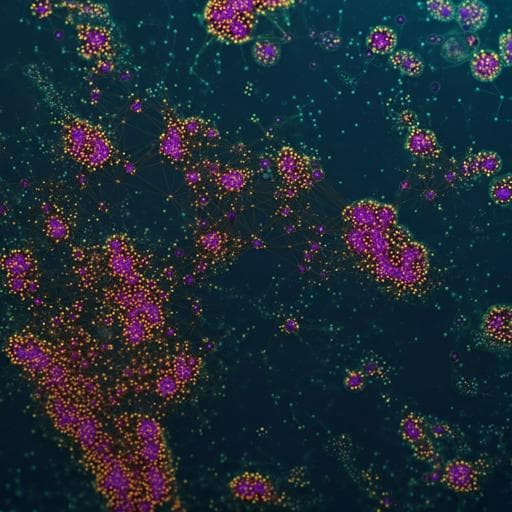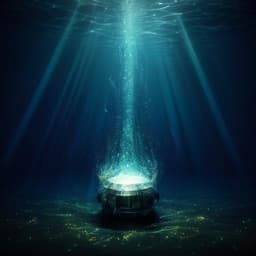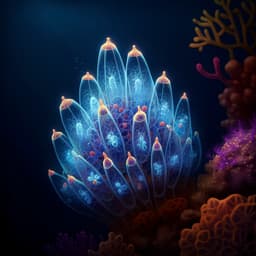
Environmental Studies and Forestry
Multidrug-resistant high-risk clonal *Escherichia coli* lineages occur along an antibiotic residue gradient in the Baltic Sea
P. Lübcke, S. E. Heiden, et al.
This groundbreaking study conducted by Phillip Lübcke and colleagues highlights the alarming presence of ESBL-producing *E. coli* in northeastern Germany's surface water. The research delves into antibiotic resistance, heavy metal tolerance, and potential reservoirs for these bacteria in the Baltic Sea, revealing critical insights about our water systems and public health.
~3 min • Beginner • English
Introduction
Antibiotics have transformed modern medicine, yet antimicrobial resistance (AMR) undermines their effectiveness. While hospitals are recognized hotspots for multidrug-resistant (MDR) pathogens like E. coli due to high antibiotic use and vulnerable patients, environmental reservoirs are often underestimated. Aquatic ecosystems can accumulate MDR bacteria and pharmaceutical residues from untreated sewage, agricultural runoff, industrial effluents, and maritime activities. The Baltic Sea, with low salinity, semi-enclosed geography, shallow depth, and slow water exchange, is particularly vulnerable to pollutant accumulation. Low-level antibiotic residues can perturb microbial communities and select for resistance, with potential bioaccumulation through food webs. From a One Health perspective, a few successful high-risk clonal E. coli lineages (e.g., ST38, ST58, ST117, ST131, ST410, ST648, ST744, ST1193) carry multiple AMR and virulence determinants and are distributed across ecosystems, even under limited antimicrobial pressure. Data on antibiotic residues and the role of the Baltic Sea as an environmental reservoir for MDR E. coli remain scarce. This study longitudinally sampled three Baltic Sea coastal sites over one year to isolate ESBL-producing E. coli, characterize their phenotypes and genomes (AMR, HM tolerance, biofilm formation, virulence, plasmids, phylogeny), and quantify antibiotic residues to test whether ESBL-E. coli occur along an antibiotic residue gradient.
Literature Review
Methodology
- Sampling and isolation: From August 2021 to August 2022 (~weekly), 124 surface water samples were collected at three sites on the German Baltic Sea coast: an urban beach (Eldena), a peri-urban site near a wastewater treatment plant (WWTP; Ladebow), and a rural site (Riems). Additional reference samples were collected from hospital wastewater and WWTP influent/effluent. After pre-filtration (4–12 µm), 100 mL were membrane-filtered (0.45 µm), filters incubated in tryptic soy broth, serially diluted, and plated on CHROMID ESBL and CHROMagar Orientation. Presumptive E. coli colonies were purified and stored.
- DNA extraction and sequencing: Total DNA was extracted (MasterPure kit), quantified (Qubit), and sequenced at SeqCenter using Illumina NovaSeq 6000 (2×151 bp). Long reads were generated on ONT R10.4.1 flow cells (Guppy v6.4.6). Reads were trimmed (fastp), QC’d (FastQC).
- Assembly and annotation: Hybrid assemblies via Unicycler and Trycycler (flye, miniasm/minipolish, raven), polished (Polypolish, POLCA), and manually merged. Annotation with Bakta. Typing and gene detection: MLST (PubMLST/EnteroBase), phylogrouping (ezClermont), AMR genes (AMRFinderPlus), virulence factors (ABRicate/VFDB), plasmid replicons (PlasmidFinder).
- Comparative genomics: Mashtree (1,000 bootstraps) for strain and plasmid relatedness; BRIG for plasmid comparison. Global context: for ST38, ST117, ST131, ST410, closest public genomes were identified (mash), SNPs/INDELs computed (Snippy), coverage assessed (BLAST/BRIG). Cefiderocol resistance exploration in ST117 via breseq (PBIO3949 as reference) and literature comparison.
- Phenotypic antimicrobial susceptibility testing: VITEK2 (AST-N428, AST-XN24) interpreted by EUCAST. Cefiderocol tested by disk diffusion (30 µg) with broth microdilution (ComASP Cefiderocol) for uncertain zones. QC with E. coli ATCC25922 and P. aeruginosa ATCC27853.
- Heavy metal/metalloid tolerance: Broth microdilution for arsenic (arsenic trioxide) and mercury (mercuric acetate); MICs determined after 20 h at 37 °C.
- Biofilm formation: Crystal violet assay on polystyrene using M9+glucose; growth-adjusted specific biofilm formation (SBF) calculated.
- In vivo virulence: Galleria mellonella larvae infection (10 µL, 10^5 CFU/larva), survival monitored up to 72 h; three independent assays pooled for six selected strains.
- Antibiotic residue analysis: Solid-phase extraction (Strata-X) with UHPLC–MS/MS (Shimadzu LCMS-8060). Target analytes: ampicillin (AMP), cefotaxime (CTX), ciprofloxacin (CIP), sulfamethoxazole (SUL), tetracycline (TET). Calibration by standard addition (0–400 ng/L), EDTA addition, pH 3.5. LOQs: AMP 6 ng/L; CTX 4 ng/L; CIP 50 ng/L; SUL 11 ng/L; TET 8 ng/L. Environmental samples (5×5 mL aliquots) and reference wastewater samples (hospital, WWTP effluent) analyzed.
Key Findings
- Occurrence and diversity: 30 ESBL-producing E. coli were isolated from 124 samples: Ladebow 60.0% (18/30), Eldena 36.7% (11/30), Riems 3.3% (1/30). Phylogroups: A 30.0% (9/30); B1 16.7% (5/30); B2 16.7% (5/30); D 16.7% (5/30); G 10.0% (3/30); F 6.7% (2/30); C 3.3% (1/30). MLST: 20 STs; repeats included ST10, ST117, ST131, ST744, ST949, ST1684. High-risk lineages detected: ST38 (n=1), ST58 (n=1), ST117 (n=3), ST131 (n=3), ST410 (n=1), ST744 (n=2), ST1193 (n=1). Three ST117 isolates were closely related (7–59 core SNPs apart) and collected over 5 months.
- Plasmids: High plasmid diversity with some clusters; ST117 strains carried 10–11 plasmids with similar ESBL/virulence content; evidence of ColRNAI plasmid circulation across unrelated strains.
- AMR genotypes: Predominant ESBLs: blaCTX-M-15 46.7% (14/30), blaCTX-M-1 23.3% (7/30); other CTX-M alleles at low frequency (CTX-M-8/14/24/27/32). ESBL gene location: chromosomal only (n=8), plasmid-encoded (n=22), with five strains carrying both. All strains had AmpC blaCMY; blaLAP-2 detected in one (PBIO3942). Five strains had blaOXA-1. Notably, all three ST117 strains carried blaOXA-1 together with blaCTX-M-1, a combination previously observed as mutually exclusive.
- AMR phenotypes: All 30 showed ESBL phenotype. Resistance rates: cotrimoxazole 53.5% (16/30); ciprofloxacin 36.7% (11/30); piperacillin/tazobactam 13.3% (4/30); gentamicin 10.0% (3/30); ceftolozane/tazobactam non-susceptible 3.3% (1/30). MDR phenotype in 63.3% (19/30). All susceptible to imipenem, meropenem, and colistin. One ST117 isolate (PBIO3948) was cefiderocol-resistant (MIC 4 µg/mL) without known resistance mutations (e.g., cirA) relative to susceptible ST117 counterparts.
- Heavy metal/metalloid tolerance: All strains carried arsenic tolerance genes (arsCDR). Arsenic MICs: 83.3% (25/30) had medium-high MICs (256–512 µg/mL); 16.7% (5/30) had 32 µg/mL. Mercury tolerance genes (merCPRT) in 23.3% (7/30); MICs typically 16–32 µg/mL; two strains showed elevated mercury MICs despite lacking mer genes. Occasional detection of copper/silver (sil/pco) and tellurium (ter) genes (one isolate each); no phenotyping for these metals.
- Virulence and biofilm: All isolates harbored virulence-associated genes (adherence, biofilm, capsule, iron uptake including aerobactin/salmochelin on plasmids, invasion, toxins). VAG counts ranged widely (mean/median 89); highest in PBIO3946 (ST131) and PBIO3949 (ST117) with 117 VAGs each; lowest in PBIO3941 (ST2741, 55) and PBIO3962 (ST744, 64). Biofilm formation varied: 60% (18/30) weak adhesion; four strains showed moderate-strong adhesion (e.g., PBIO4272 SBFmean 2.93). No significant difference in adhesion between high-risk and other lineages (p=0.9502). In Galleria mellonella, mortality varied (PBIO3941 up to 90% mortality; others ~46.7–66.7% at 72 h).
- Antibiotic residues: In coastal water, CIP at Ladebow ranged 30.99–553.0 ng/L (highest in Dec 2021 and Mar 2022); SUL generally 31.27–90.35 ng/L with peaks at 149.62 ng/L (Dec 2021) and 281.80 ng/L (Jan 2022). CTX and TET were below LOQ in all environmental samples. Antibiotics were higher in wastewater: hospital wastewater mean CIP 286.40 µg/L (~1000× highest Ladebow); WWTP effluent mean CIP 1.79 µg/L; TET below LOQ in wastewater. ESBL-producing E. coli occurred along this antibiotic residue gradient.
Discussion
The study demonstrates that Baltic Sea coastal waters in northeastern Germany harbor ESBL-producing E. coli, including internationally disseminated high-risk clonal lineages (e.g., ST117, ST131, ST410, ST744) with substantial AMR and virulence gene content. Many isolates were phenotypically MDR, and one (ST117) displayed resistance to the last-resort antibiotic cefiderocol, underscoring clinical relevance. Heavy metal tolerance was common, particularly to arsenic, and present for mercury in a subset; discrepancies between genotypes and phenotypes for mercury suggest additional, uncharacterized mechanisms. Co-location of metal tolerance and AMR genes on plasmids highlights potential co-selection, while the presence of stable resistance plasmids may maintain AMR under low antibiotic pressure. Biofilm formation varied markedly even within STs, implying diverse strategies for environmental persistence that could influence survival and transmission. Antibiotic residues in the Baltic Sea were generally low compared to wastewater, yet CIP and SUL were detectable and occasionally exceeded proposed PNECs, although no clear association was observed between residue levels and resistance patterns in isolates. The proximity of contaminated sites to recreational areas (e.g., Eldena beach) raises public health concerns due to potential exposure. The findings emphasize the One Health implications of environmental AMR reservoirs and the need for improved wastewater treatment and regulatory limits on pharmaceutical discharges to mitigate environmental selection and dissemination of MDR bacteria.
Conclusion
This work provides a comprehensive, year-long analysis showing that ESBL-producing, often MDR E. coli—including high-risk clonal lineages—are present in Baltic Sea coastal waters and occur along a gradient of antibiotic residues from hospital wastewater and WWTP effluent to the marine environment. Genomic and phenotypic characterization revealed extensive AMR determinants, notable heavy metal tolerance, diverse biofilm-forming capacities, and clinically relevant virulence profiles, including a cefiderocol-resistant ST117 isolate. These findings highlight environmental waters as reservoirs and potential transmission routes for MDR E. coli. Future research should (i) elucidate mechanisms of cefiderocol resistance and heavy metal tolerance, (ii) expand longitudinal sampling to resolve spatial/seasonal trends and link residues to selection, (iii) investigate plasmid-mediated co-selection and stability, and (iv) evaluate mitigation strategies, including advanced wastewater treatment and evidence-based regulatory thresholds for antibiotic emissions.
Limitations
- The mechanism underlying cefiderocol resistance in PBIO3948 (ST117) was not identified.
- Galleria mellonella virulence assessment included a small, non-random subset of strains, limiting generalizability.
- Environmental residue sampling, while longitudinal, was limited in scope for robust seasonal/spatial trend analysis and linkage to resistance selection.
- Affiliation 7 for some authors is not detailed in the provided text.
- Phenotype–genotype discrepancies for mercury tolerance indicate uncharacterized determinants not captured by the applied gene panels.
Related Publications
Explore these studies to deepen your understanding of the subject.







